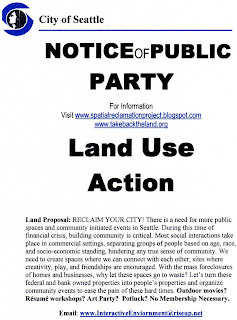The Spatial Reclamation Project
Space Rec organizes interactive artworks that encourage people to engage with public space in new and inventive ways. creative geography-political economy-interventionist-activism-reclamations of our ontological autonomy. Lets Make.
Thursday, August 9, 2012
Shelter -- LLOYD KAHN
Check out this awesome book! Shelter is a book with over 1000 photos of homemade buildings all over the world--with little diagrams, detailed instructions, short poems and stories. It is as essential as a survival guide and as intimate as reading a private journal.
http://www.shelterpub.com/_shelter/shelter_book.html
Wednesday, June 17, 2009
Favela Land Proposal
The Peoples' Print Project




The Peoples' Print Project is an alternative media, thought box, open-to-the-public-ation. Its a two-tiered mechanism: one part print-stop, containing paper, pen, some mild guidelines and Space Rec leaflet-- equal part drop-stop, thought box, labeled depository; the community dissemination station. We left them in unobtrusive locations to avoid untimely dismantlement. The woodland park Print is in an off-the-beaten-track woody cluster between the roses and the zoo. Most likely, it will find some young explorers.
The other Print was left off to the side of the Shilshole tracks where it'll find a lot of graffiti artists. We didn't want the Print to be secluded to it's built-in audience so we made MAPS! The maps will be continuously dispersed in between stacks of news papers, public library books, and through other random operations.
Wednesday, April 15, 2009
Friday, March 20, 2009
Personal Map Project

*Click on the picture to view more Personal Maps
If biases exist in popular maps, these same biases are reflected in the manner in which we move and experience our world.
-Nato Thompson from the book Experimental Geography: radical approaches to landscape, Cartography, and Urbanism
Hey! It's a psycho-geographical, counter-cartography, map-making project! We thought it would be interesting to see how different people interpret and visualize their spaces, where biases exist, the symbols and language they would use, the areas they would leave out, and how their spatial practices would be expressed within their personal cartography. They illustrated their lives, favorite spots, routes and sites to share their environments with us.
Tuesday, March 17, 2009
Peripheralized Man






The Peripheralized Man:
The journey of The Peripheralized Man begs the question of how things like development, huge wealth gaps, and the structuring of our communities have an impact on how we know our neighbors, what we value, and who gets left out.
To read about Ms. Macefield's house in the PI follow these links:
http://seattlepi.nwsource.com/
http://seattlepi.nwsource.com/
http://seattlepi.nwsource.com/
and this from the NYtimes
http://www.nytimes.com/2008/12/28/us/28edith.html
Tuesday, March 3, 2009
Critical Corpus




This Critical Corpus is a life-size tape cast of a 5' ft. 11' in. male. We stuffed our man, "Corpo" with 70lbs of warm, once, twice, thrice-loved clothes, toys, baby bottles, shoes, blankets. Then we carried our stiff commodity corps and left him to sun bath in the middle of the Westlake Center Plaza.
A little girl plopped right in his lap. Some people took Corpo's picture with their camera phones. Others ripped off his head and gutted him for loot.
Why did we build a life sized corpse, name it Corpo, and pack him full of stuff? Firstly, we're always looking for creative ways to address the needs of our community--and we're tryn to do it as participatory public art made with reclaimed materials, making sure blankets and clothes end up on backs instead of in fresh kills land fills.
We thought about how we should present Corpo to the world: "hmmmm, lets drop a card-board sign with him that says 'The Need is Clear' or 'Asking for Change'". But after some thought we were like "nawww, veto the signs" because its not just about keeping warm clothes on peoples backs, even though that shits real. Conceptually, we didnt want him to only represent stuff. Meaning we didnt want the message to be that it sucks to be poor because you can't buy stuff, or that giving stuff to people who don't have any is some how going to solve poverty. We wanted Corpo to assist in a public understanding of the causes of systemic poverty in our city... in the world! Mainly from a spatial standpoint.
So we figured this: without a sign, Corpo would be a body full of all the shit we need to keep warm, feed and entertain our kids, stuff we like to buy, buy, buy--If we ditched Corpo smack in the middle of DT shopping district, his body would look like a landscape and he'd be more than just an odd lookin' sculpture full of shit. He'd represent the feedback loop between "the body," and the ideology, culture & values of "the body," and of how all that gets built into the physical landscape--which then goes on to reinforce and perpetuate the same ideology, culture, and values into more & more & more bodies.
In other words, Corpo's clear product-filled corpse is not only a reflection of the commercial landscape that we left him in, but also of how capitalism fashions the body and our identities.
Corpo was left for public dismantlement and humiliation (poor corpo...). And maybe, juuust maybe, someone found the sweater, or jacket, or creepy neon-green-alien-stuffed-animal they were looking to buy, except recycled and for free(!) from the belly of our boy, Corpo.
Subscribe to:
Comments (Atom)





